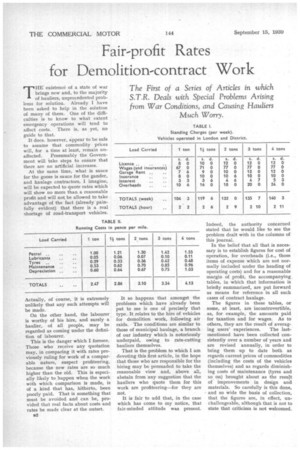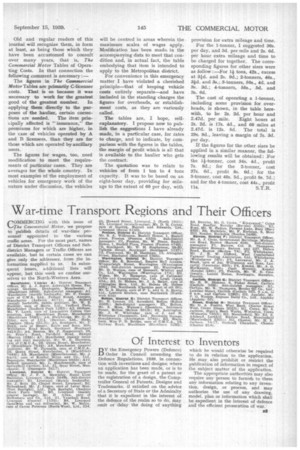• Fair-profit Rates for Demolition-contract Work
Page 28

Page 29

If you've noticed an error in this article please click here to report it so we can fix it.
THE existence of a state of war brings new and, to the majority of hauliers, unprecedented problems for solution. Already I have been asked to help in the solution of many of them. One of the difficulties is to know to what extent emergency operations will tend to affect costs. There is, as yet, no guide to that.
It does. however, appear to be safe to assume that commodity prices will, for a time at least, remain unaffected. Presumably the Government will take steps to ensure that there are no artificial increases.
At the same time, what is sauce for the goose is sauce for the gander, and haulage contractors, I imagine, will be expected to quote rates which will show no more than a reasonable profit and will not be allowed to take advantage of the fact (already painfully evident) that there is a real shortage of road-transport vehicles.
Actually, of course, it is extremely unlikely that any such attempts will be made.
On the other hand, the labourer is worthy of his hire, and surely a haulier, of all people, may be regarded as coming under the definition of labourer.
This is the danger which I foresee. Those who receive any quotation may, in comparing it with rates previously ruling for work of a comparable nature, suspect profiteering, because the new rates are so much higher than the old. This is especially likely to happen when the work with which comparison is made, is of a kind that has, hitherto, been poorly paid. That is something that must be avoided and can be, provided that real facts about costs and rates be made clear at the outset.
B2
It so happens that amongst the problems which have already been put to me is one of precisely that type. It relates to the hire of vehicles for demolition work, following air raids. The conditions are similar to those of municipal haulage, a branch of our industry which is notoriously underpaid, owing to rate-cutting hauliers themselves.
That is the problem to which I am devoting this first article, in the hope that those who are responsible for the hiring may be persuaded to take the reasonable view and, above all, abstain from any suggestion that the hauliers who quote them for this work are profiteering-for they are not.
It is fair to add that, in the case which has come to my notice, that fair-minded attitude was present.
Indeed, the authority concerned stated that he would like to see the problem dealt with in the columns of this journal.
In the belief that all that is necessary is to establish figures for cost of operation, for overheads (i.e., those items of expense which are not normally included under the heading of operating costs) and for a reasonable margin of profit, the accompanying tables, in which that information is briefly summarized, are put forward as means for reference in all such cases of contract haulage.
The figures in these tables, or some, at least, are incontrovertible, as, for example, the amounts paid for taxation and for wages. As to others, they are the result of averag
ing users' experiences. The lastmentioned have been collected consistently over a number of years and are revised annually, in order to bring them up to date both as regards current prices of commodities (including the costs of the vehicles themselves) and as regards diminishing costs of maintenance (tyres and so on) brought about as the result of improvements in design and materials. So carefully is this done, and so wide the basis of collection, that the figures are, in effect, unchallengeable, although that is not to state that criticism is not welcomed.
Old and regular readers of this journal will recognize them, in form at least, as being those which they have been accustomed to consult over many years, that is, The Commercial Motor Tables of Operating Costs. In that connection the following comment is necessary:— The figures in The Commercial Motor Tables are primarily C-licensee costs. That is so because it was necessary to work for the greatest good of the greatest number. In applying them directly to the purposes of the haulier, certain correc
tions are needed. The item principally affected is "insurance," the premiums for which are higher, in the case of vehicles operated by A and B licensees, than they are for those which are operated by ancillary users.
The figures for wages, too, need modification to meet the requirements of particular cases. They are averages for the whole country. In most examples of the employment of vehicles for emergency work of the nature under discussion, the vehicles will be centred in areas wherein the maximum scales of wages apply. Modification has been made. in the accompanying data to meet that condition and, in actual fact, the table embodying that item is intended to apply to the Metropolitan district.
For convenience in this emergency matter I have violated a cherished principle—that of keeping vehicle costs entirely separate--and have included in the standing charges the figures for overheads, or establishment costs, as they are variously The tables are, I hope, selfexplanatory. I propose now to publish the suggestions I have already made, in a particular case, for rates to charge, and to indicate, by comparison with the figures in the tables, the margin of profit which is all that is available to the haulier who gets the contract.
The quotation was to relate to vehicles of frora 1 ton to 4 tons capacity. It was to be based on an eight-hour day, providing for mileage to the extent of 60 per day, with provision for extra mileage and time.
For the 1-tonner, I suggested 36s. per day, and 3d. per mile and 2s. 6d. per hour extra mileage and time to be charged for together. The corresponding figures for other sizes were as follow :—For I tons, 42s., excess at aid. and 2s. 9d.; 2-tonners, 48s., 3icl. and 3s.; 3-tonners, 50s., 4d. and 3s. 3d.; 4-tonners, 55s., 5d. and 3s. 6d.
The cost of operating a 1-tonner, including some provision for overheads, is shown, in the table herewith, to be 2s. 2d. per hour and 2.47d. per mile. Eight hours at 2s. 2d. is 17s. 4d., and 60 miles at 2.47d. is 12s. 5d. The total is 29s. 9d., leaving a margin of 7s. 3d. per day.
If the figures for the other sizes be applied in a similar manner, the following results will be obtained: For the li-tonner, cost 34s. 4d., profit 7s. 8d.; for the 2-tonner, cost 37s. 6d., profit 8s. 6d.; for the 3-tonner, cost 40s. 5d., profit 9s. 7d.; and for the 4-toriner, cost 44s., profit 11s. S.T.R.




























































